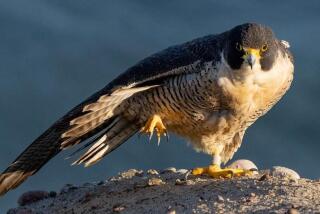Soaring Falcons Produce Cleaner Water Off Beach
SANTA BARBARA — Here at the Tajiguas Landfill, where 650 tons of fresh garbage are dumped each day, a sport of kings is meeting the needs of the common man.
A pair of falcons rides the air currents above the 80-acre site, keeping thousands of sea gulls at bay. Where once the sky was white with birds and the land was white with guano, a scant dozen of the more daring gulls circle the site from a wary distance.
Since the county turned to falconry to control the gulls last spring, heavy-equipment operators can work all day without stopping to scrub away bird droppings so thick that they obscured their windshields and so noxious that they ate through paint and metal. Visitors to Tajiguas no longer have to wear hats.
Most surprising, however, is the sudden rise in water quality at nearby Arroyo Quemado beach. It was once the filthiest beach in Santa Barbara--and last year in all of Southern California--but gull-free Arroyo Quemado’s waters have logged 15 weeks of passing grades. Local residents welcome the cleaner water, and county officials plan to use the turnabout to make a case for extending the life of the controversial landfill by 15 years.
“The falcons were an experiment, really, and the results have been truly amazing,” said Mark Schleich, director of the county’s solid waste division. “That beach was a mess, and for the first time in five years, since the falcons came, the water is testing clean.”
Falconry, a 4,000-year-old sport defined as the pursuit of quarry with a trained raptor, was once practiced only by the rich and titled. Over the millenniums it has become a passion for some of the less well-heeled. Of the estimated 4,400 licensed falconers in the United States, about 600 live in California. Most use their birds for sport, but a growing number are putting them to work.
Tom Stephan founded his Ramona, Calif.-based company, Air Superiority Falconry Services, seven years ago. His 15 birds have flown missions as varied as stopping starlings from eating grapes at Central Coast vineyards and helping the Air Force protect the sensitive skin of $2-billion Stealth bombers from pigeon droppings.
“We would ride a crane to a motorized catwalk near the ceiling of the Stealth hangar and let the falcons go,” said Stephan, now 42, who became a falconer when he was 14. The pigeons soon sought a safer place to roost.
“It’s a natural predator-prey relationship, and it’s the most effective way to control nuisance birds,” Stephan said. “Plus, falcons are beautiful, just beautiful in everything they do.”
Historians call falconry the world’s oldest sport. It’s certainly one of the most regulated. In the U.S., falconers are required to have licenses from state fish and game departments. Their training begins with an apprenticeship, includes study of history and lore as well as the intricacies of bird keeping, and culminates with written and practical exams.
“Falconry is a lifestyle,” said Jeff Diaz, the falconer whose birds now patrol the landfill in Santa Barbara. “The relationship you develop with your birds is beyond words.”
Diaz stumbled onto the Tajiguas job. “I had heard that the county was thinking about using falcons for their gull problem, so I took a chance and drove down to the landfill,” he said.
Officials from the county solid waste department happened to be there, watching the thousands of gulls that had ignored firecrackers, bird bombs and piped-in distress calls.
Within minutes of the falcons’ first flight, the sea gulls had dispersed. Within weeks, Arroyo Quemado beach had posted its cleanest water ratings in five years. County officials were so impressed that they gave Diaz a one-year contract that comes to about $95,000.
“I knew that airports used falcons to keep birds from their runways,” said Kathy Kefauver, a wildlife biologist who had the idea of using a falconer at the site. “But seeing Jeff work the birds and watching the gulls leave the working face of the landfill was impressive.”
So were the water quality numbers. DNA tests had shown that 80% of the pollution at Arroyo Quemado beach came from gull droppings, but getting rid of the birds without killing them had flummoxed county officials. The falcons just frighten the gulls. Unlike firecrackers or bird calls, which the gulls quickly learned to ignore, the fear of predators is hard-wired into their consciousness.
Not everyone is impressed. Hillary Hauser, founder of Heal the Ocean, an environmental organization that wants to shut down the Tajiguas dump, sees the falcons as something of a parlor trick. Though the birds cleaned up the water at Arroyo Quemado beach, that doesn’t convince Hauser that the county should give the landfill a 15-year extension.
“The falcons are amusing, but they don’t solve the landfill problem,” Hauser said. “What it boils down to is the county is trying to push the expansion of an environmental hazard on the back of a pair of falcons. That’s absurd.”
More to Read
Sign up for Essential California
The most important California stories and recommendations in your inbox every morning.
You may occasionally receive promotional content from the Los Angeles Times.










